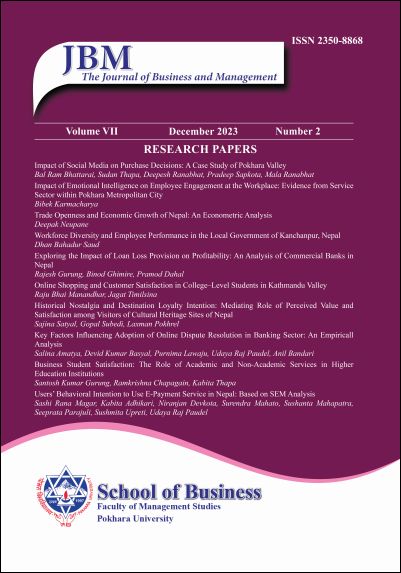Users’ Behavioral Intention to Use E-Payment Service in Nepal: Based on SEM Analysis
DOI:
https://doi.org/10.3126/jbm.v7i02.62592Keywords:
E-payment, structural equation modeling, user behavior intentionAbstract
Background: Digital payments were revolutionized after 1990 in Nepal’s payment system, and the rise of ICT and mobile tech since 2010 led customers to embrace e-payments. While e-payment adoption grows, progress is needed to make bank cards default for online purchases and enhance user awareness and trust for secure digital transactions. Further, understanding user perspectives and influencing factors is crucial.
Objectives: This study aims to analyze the intention of users to use e-payment services in the Nepalese context.
Methods: Explanatory research design is used to meet the purpose of the study. A total of 295 respondents were selected as users of the e-payment services are increasing and there is no exact number of users identified. A structured questionnaire was developed and a pretest was carried out on 10% of the sample. Data is collected from the survey through the structured questionnaire and used the Kobo Toolbox and Interviewed from Key Informants Interview (KII) method.
Results: The study shows mobile banking users are highly increasing yearly, followed by internet banking with growing users. The SEM result depicts the significant relationship between behavioral intention on user satisfaction (β = 0.191, P < 0.05), perceived usefulness (β = 0.099, P < 0.05), perceived ease of use (β = 0.084, P < 0.05), social influence (β = 0.064, P < 0.05) and perceived credibility (β =0.096, P < 0.05). Furthermore, improved credibility and ease in e-payment functions can enhance customer satisfaction.
Conclusion: The study concluded that Perceived Credibility (PC), Perceived Usefulness (PU), Perceived Ease of and Social Influence (SCI) have an impact on user satisfaction and Behavioral Intention (BI) to use the e-payment system. Additionally, User Satisfaction was also found to be related to Behavioral Intention (BI) to use an e-payment system.
Downloads
Downloads
Published
How to Cite
Issue
Section
License
Copyright © the School of Business. All rights reserved. No part of this volume may be reproduced or utilized in any form or by any means, electronic or mechanical, including photocopying, recording, or by and information storage and retrieval system, without permission in writing from the publisher.




